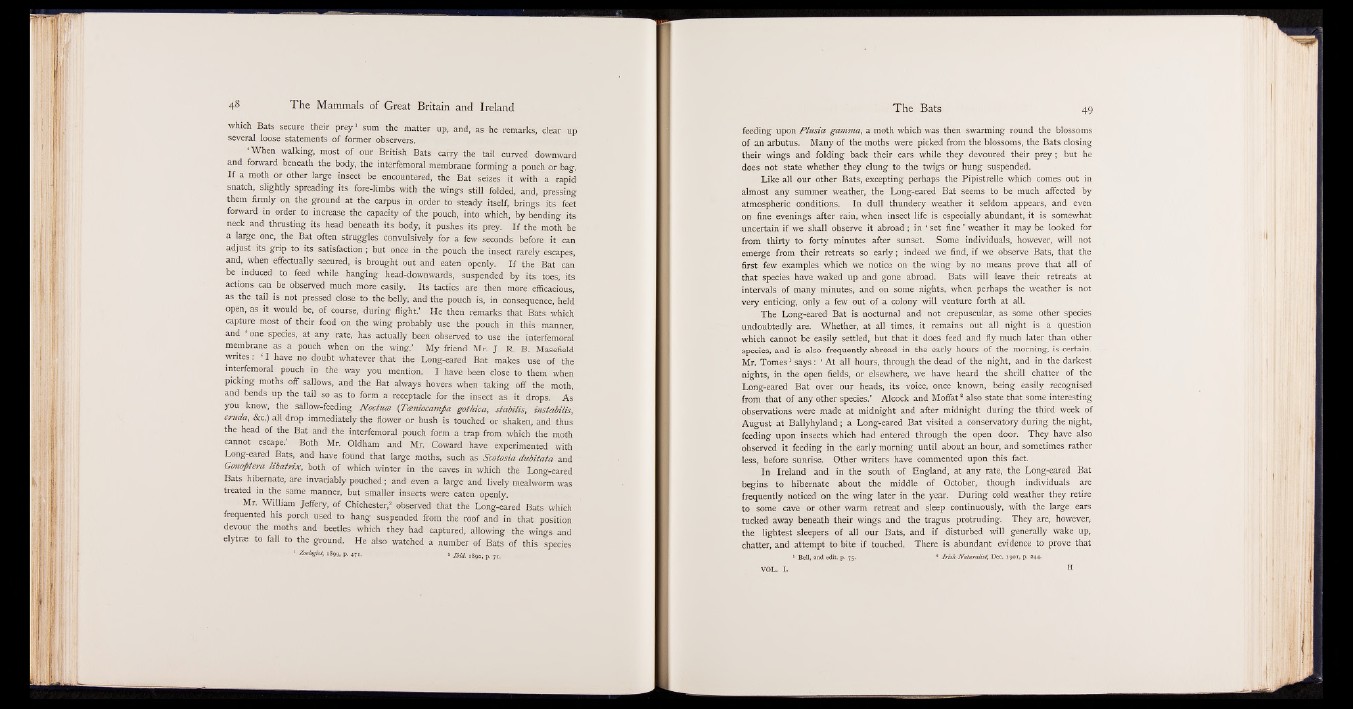
which Bats secure their prey1 sum the matter up,, and, as he remarks, clear up
several loose statements of former observers.
‘When walking, most of our British Bats carry the tail curved downward
and forward beneath the body, the interfemoral membrane forming a pouch or bag.
I f a moth or other large insect be encountered, the Bat seizes it with a rapid
snatch, slightly spreading its fore-limbs with the wings still folded, and, pressing
them firmly on the ground at the carpus in order to steady itself, brings its feet
forward in order to increase the capacity of the pouch, into which, by bending its
neck and thrusting its head beneath its: body, it pushes its prey. I f the moth be
a laige one, the Bat often struggles convulsively for a few seconds before it can
adjust its grip to its satisfaction ; but once in the pouch the insect rarely escapes,
and, when effectually secured,ids brought out and eaten openly. If the Bat can
be induced to feed while hanging head-downwards, suspended by its toes; its
actions can be observed much more easily. Its tactics are then more efficacious,.
as the tail is not pressed close to the belly, and the pouch is, in consequence, held
open; as it would be, of course, during flight.' He then remarks that Bats which
capture most of their food on the wing probably use the pouch in this manner,
and ‘ one species, at any rate, has actually been observed to use the interfemoral
membrane as a pouch when on the wing.’ My friend Mr. J. R. B. Masefield
writes: ‘ I have no doubt whatever that the Long-eared Bat makes use of the
interfemoral: pouch in the way you mention. I have been close" to them when
picking moths off sallows, and the Bat always hovers when taking off the moth,
and bends up the tail so as to form a receptacle for the insect as it drops. As
you know, the sallow-feeding Noctua (1Tamiocampa gothica, stabilis, instatnlis,
cruda, &c.) alhdrop immediately the flower j p bush is touched or shaken, and thus
the head of the Bat and the interfemoral pouch form a trap from which the moth
cannot escape. Both Mr. Oldham and Mr. Coward have experimented with
Long-eared Bats, and have found that large moths, such as Scotosia dubitata and
Gonoptera M atrix, both of which winter in the caves in which the Long-eared
Bats hibernate, are invariably pouched; and even a large and lively mealworm was
treated in the same manner, but smaller insects were eaten openly.
Mr. William Jeffery, of Chichester,2 observed that the Long-eared Bats which
frequented his porch used to hang; suspended from the roof and in that position
devour the moths and beetles which they had Captured, allowing the wings and
elytrm to fall to the ground. He also watched d number of Bats of this species
■ 1 1899, p. 471. • Tbid. 1890, p. 71.
feeding upon Plusia gamma, a moth which was then swarming round the blossoms
of an arbutus. Many of the moths were picked from the blossoms, the Bats closing
their wings and folding back their ears while they devoured their prey; but he
does not state whether they clung to the twigs or hung suspended.
Like all our other Bats, excepting perhaps the Pipistrelle which comes out in
almost any summer weather, the Long-eared Bat seems to be much affected by
atmospheric conditions. In dull thundery weather it seldom appears, and even-
on fine evenings after rain, when insect life is especially abundant, it is somewhat
uncertain if we shall observe it abroad ; in ‘ set fine ’ weather it may be looked for
from thirty to forty minutes after sunset. Some individuals, however, will not
emerge from their retreats so early; indeed we find, if we observe Bats, that the
first few examples which we notice on the wing by no means prove that all of
that species have waked up and gone abroad. Bats will leave their retreats at
intervals of many minutes, and on some nights, when perhaps the weather is not
very enticing, only a few out of a colony will venture forth at all.
The Long-eared Bat is nocturnal and not crepuscular, as some other species
undoubtedly are. Whether, at all times, it remains out all night is a question
which cannot be easily settled, but that it does feed and fly much later than other
species, and is also frequently abroad in the early hours of the morning, is certain.
Mr. Tomes1 satys: ‘ At all hours, through the dead of the night, and in the darkest
nights, in the open fields, or elsewhere, we have heard the shrill chatter of the
Long-eared Bat over our heads, its voice, once known, being easily recognised
from that of any other species.’ Alcock and Moffat3 also state that some interesting
observations were made at midnight and after midnight during the third week of
August at Ballyhyland; a Long-eared Bat visited a conservatory during the night,
feeding upon insects which had entered through the open door. They have also
observed it feeding in the early morning until about an hour, and sometimes rather
less, before sunrise. Other writers have commented upon this fact.
In Ireland and in the south of England, at any rate, the Long-eared Bat
begins to hibernate about the middle of October, though individuals are
frequently noticed on the wing later in the year. During cold weather they retire
to some cave or other warm retreat and sleep continuously, with the large ears
tucked away beneath their wings and the tragus protruding. They are, however,
the lightest sleepers of all our Bats, and if disturbed will generally wake up,
chatter, and attempt to bite if touched. There is abundant evidence to prove that
1 Bell, and edit. p. 75. s Irish N a tu ra listDec. 1901, p. 244.
VOL. I.